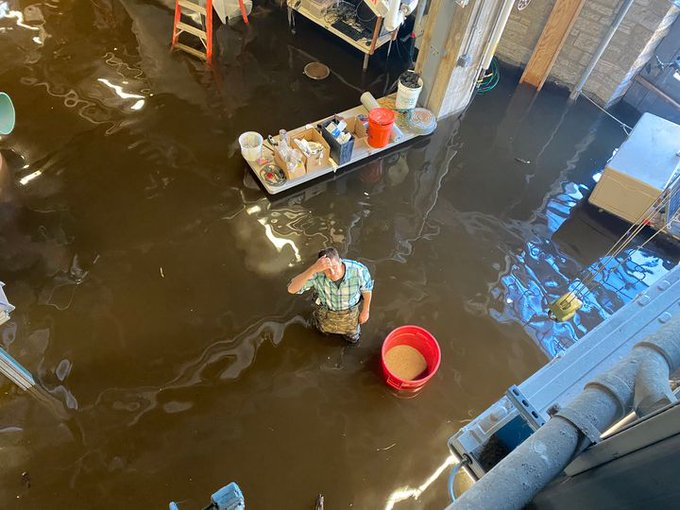Troubleshooting lab drainage and flooding

The Silent Threat: Lab Flooding and its Impact on Scientific Progress

In the realm of scientific research, laboratories stand as the epicenter of innovation, where groundbreaking discoveries are made and the frontiers of knowledge are pushed further. These meticulously designed spaces house an intricate network of equipment, instruments, and chemicals, all meticulously orchestrated to facilitate the pursuit of scientific truth. However, beneath the surface of this controlled environment lies a silent threat – the potential for lab flooding.
Lab flooding, a seemingly innocuous event, can have devastating consequences, disrupting research activities, jeopardizing the safety of personnel, and incurring significant financial losses. The impact of flooding extends far beyond the immediate damage to equipment and infrastructure, reaching into the very core of scientific progress.
The consequences of lab flooding are multifaceted and far-reaching. The immediate impact is the disruption of ongoing research projects. Valuable samples, reagents, and experimental data can be irrevocably lost, setting back research timelines and jeopardizing the integrity of scientific findings. The financial implications are equally substantial, encompassing the cost of replacing damaged equipment, repairing infrastructure, and potentially halting research activities for extended periods.
Beyond the tangible losses, lab flooding poses a significant threat to the safety of personnel. The presence of hazardous chemicals and biological agents can create a toxic environment, posing risks of exposure and potential health complications. The disruption of safety protocols and emergency procedures can further exacerbate the situation, leading to unforeseen consequences.
The potential for lab flooding is a pressing concern for all stakeholders in the scientific community. From lab technicians and project managers to procurement officers and C-suite executives, understanding the causes, consequences, and mitigation strategies for lab flooding is paramount. This article delves into the intricacies of lab drainage and flooding, providing insights into the underlying causes, the potential risks, and practical solutions to prevent and manage these events.
The focus will be on the critical role of Public Health Engineering in ensuring the safety and functionality of laboratory spaces. By examining the principles of drainage design, maintenance practices, and the integration of advanced technologies, this article aims to empower stakeholders with the knowledge and tools necessary to mitigate the risks of lab flooding and safeguard the integrity of scientific research.
The journey begins with a comprehensive exploration of the causes of lab flooding, delving into the intricacies of drainage systems, the impact of human error, and the role of environmental factors. This analysis will provide a foundation for understanding the vulnerabilities inherent in laboratory spaces and the potential triggers for flooding events.
The article will then delve into the consequences of lab flooding, examining the impact on research activities, the financial implications, and the potential safety hazards. This exploration will highlight the critical need for proactive measures to prevent flooding and the importance of robust emergency response protocols.
Finally, the article will present a comprehensive framework for mitigating the risks of lab flooding. This framework will encompass best practices for drainage design, maintenance procedures, and the integration of advanced technologies. By implementing these strategies, stakeholders can create a safer and more resilient laboratory environment, safeguarding the integrity of scientific research and ensuring the well-being of personnel.
This exploration into the complexities of lab drainage and flooding is not merely an academic exercise. It is a call to action, urging stakeholders to prioritize the safety and functionality of laboratory spaces. By understanding the underlying causes, the potential consequences, and the available mitigation strategies, we can collectively work towards preventing lab flooding and ensuring the continued advancement of scientific progress.
The Silent Threat: Understanding the Importance of Lab Drainage and Flooding Prevention
In the bustling world of scientific research, laboratories are the epicenters of discovery, where groundbreaking experiments are conducted, and life-changing innovations are born. However, beneath the surface of this scientific endeavor lies a silent threat – the potential for lab drainage and flooding. While often overlooked, these seemingly mundane issues can have catastrophic consequences, disrupting research, jeopardizing safety, and even impacting public health.
The consequences of lab drainage and flooding extend far beyond mere inconvenience. They can lead to the loss of valuable research materials, equipment damage, and even the contamination of sensitive samples. In the worst-case scenario, flooding can pose a serious threat to the health and safety of lab personnel, potentially exposing them to hazardous chemicals and biological agents. The impact of such incidents can be far-reaching, disrupting research progress, delaying critical projects, and even jeopardizing the integrity of scientific findings.
The importance of effective lab drainage and flooding prevention cannot be overstated. It is a critical component of laboratory safety and a fundamental aspect of responsible scientific practice. By understanding the potential risks and implementing robust preventative measures, laboratories can mitigate the threat of drainage and flooding, ensuring the continuity of research, the safety of personnel, and the integrity of scientific endeavors.
The Complexities of Lab Drainage: A Deeper Dive
Lab drainage systems are often complex, designed to handle a wide range of waste streams, including chemical, biological, and radioactive materials. These systems must be meticulously engineered and maintained to ensure the safe and efficient disposal of hazardous waste. The failure of any component within the drainage system can lead to leaks, blockages, and ultimately, flooding.
The design of lab drainage systems is crucial for preventing flooding. Factors such as the type of research conducted, the volume of waste generated, and the specific hazards associated with the lab's activities must be carefully considered. The system should be designed to handle the anticipated flow rates and to prevent the accumulation of debris or sediment that can lead to blockages.
Beyond design, proper maintenance is essential for ensuring the long-term functionality of lab drainage systems. Regular inspections, cleaning, and repairs are crucial for identifying and addressing potential issues before they escalate into major problems. This includes checking for leaks, inspecting the condition of pipes and drains, and ensuring that all valves and traps are functioning correctly.
The Role of Public Health Engineering in Lab Safety
Public Health Engineering plays a vital role in ensuring the safety and functionality of lab drainage systems. This specialized field encompasses the design, construction, and maintenance of infrastructure that protects public health, including water supply, sanitation, and waste management.
Public Health Engineers are trained to understand the complexities of lab drainage systems and to design solutions that meet the specific needs of research facilities. They are also equipped to assess the risks associated with hazardous waste disposal and to implement measures that minimize the potential for environmental contamination.
The expertise of Public Health Engineers is essential for ensuring the safety and efficiency of lab drainage systems. Their knowledge of relevant regulations, best practices, and innovative technologies enables them to design and implement solutions that protect both the environment and the health of lab personnel.
Understanding the Causes of Lab Flooding
Lab flooding can occur due to a variety of factors, including:
- Blockages in drains and pipes: Debris, sediment, and chemical residues can accumulate in drains and pipes, restricting the flow of water and leading to back-ups and flooding.
- Leaks in pipes and fittings: Over time, pipes and fittings can deteriorate, leading to leaks that can cause significant flooding, especially in areas with high water pressure.
- Overflowing sinks and drains: Improper use of sinks and drains, such as pouring large volumes of liquids or disposing of inappropriate materials, can lead to overflows and flooding.
- Heavy rainfall and storm surges: Extreme weather events can overwhelm drainage systems, leading to flooding in laboratories located in areas prone to heavy rainfall or storm surges.
- Equipment malfunctions: Malfunctioning equipment, such as water baths, autoclaves, and centrifuges, can lead to leaks and flooding if not properly maintained or repaired.
- Human error: Accidental spills, improper disposal of chemicals, and negligence in following safety protocols can contribute to lab flooding.
The Impact of Lab Flooding: A Multifaceted Threat
The consequences of lab flooding are far-reaching, impacting various aspects of laboratory operations and potentially posing significant risks to personnel and the environment.
- Loss of research materials and equipment: Flooding can damage or destroy valuable research materials, including samples, reagents, and equipment, leading to significant financial losses and delays in research progress.
- Contamination of samples and reagents: Flooding can introduce contaminants into samples and reagents, compromising the integrity of research data and potentially leading to inaccurate or misleading results.
- Damage to infrastructure and equipment: Flooding can cause extensive damage to laboratory infrastructure, including walls, floors, ceilings, and electrical systems, requiring costly repairs and potentially disrupting operations for extended periods.
- Health and safety risks: Flooding can expose lab personnel to hazardous chemicals, biological agents, and other contaminants, posing serious health risks and potentially leading to injuries or illnesses.
- Environmental contamination: Flooding can release hazardous chemicals and biological agents into the environment, posing risks to public health and the ecosystem.
- Reputational damage: Lab flooding incidents can damage the reputation of research institutions, leading to loss of public trust and funding opportunities.
Preventing Lab Flooding: A Multi-Layered Approach
Preventing lab flooding requires a comprehensive approach that addresses all potential causes and incorporates multiple layers of protection.
- Regular inspections and maintenance: Regular inspections of drainage systems, pipes, fittings, and equipment are essential for identifying and addressing potential issues before they escalate into major problems. This includes checking for leaks, inspecting the condition of pipes and drains, and ensuring that all valves and traps are functioning correctly.
- Proper waste disposal: Implementing strict protocols for waste disposal, including the use of appropriate containers and disposal methods, is crucial for preventing blockages and overflows in drainage systems.
- Training and education: Training lab personnel on proper waste disposal, safety procedures, and the importance of reporting potential issues is essential for preventing accidents and ensuring the safe operation of laboratory facilities.
- Emergency preparedness: Developing and implementing emergency plans for responding to lab flooding events is crucial for minimizing damage, protecting personnel, and ensuring a swift recovery. This includes identifying potential flood risks, establishing evacuation procedures, and ensuring access to emergency equipment and supplies.
- Use of appropriate materials and equipment: Selecting materials and equipment that are resistant to corrosion, chemicals, and water damage is essential for minimizing the risk of leaks and flooding. This includes using corrosion-resistant pipes and fittings, selecting equipment with leak-proof seals, and ensuring that all electrical systems are properly grounded.
- Collaboration with Public Health Engineers: Consulting with Public Health Engineers during the design and construction of laboratory facilities is crucial for ensuring that drainage systems are properly engineered and meet the specific needs of the research activities conducted. Public Health Engineers can also provide guidance on best practices for waste disposal, safety protocols, and emergency preparedness.
The Importance of a Proactive Approach
Preventing lab flooding is not a one-time event but an ongoing process that requires a proactive and comprehensive approach. By implementing robust preventative measures, laboratories can significantly reduce the risk of flooding, ensuring the safety of personnel, the integrity of research, and the continuity of scientific endeavors.
The consequences of lab flooding can be severe, impacting research progress, jeopardizing safety, and even harming the environment. By understanding the potential risks and implementing effective preventative measures, laboratories can mitigate the threat of drainage and flooding, ensuring the continued success of scientific research and the protection of public health.
Public Health Engineering: Crucial for Lab Safety
The intricate interplay between laboratory operations and public health engineering is undeniable. A well-designed and maintained laboratory drainage system is not just a matter of convenience; it's a cornerstone of lab safety and environmental protection. The potential consequences of neglecting drainage issues can be severe, ranging from minor inconveniences to significant health risks and environmental damage.
This article has delved into the critical aspects of troubleshooting lab drainage and flooding, highlighting the importance of proactive maintenance, effective troubleshooting strategies, and the role of Public Health Engineering in ensuring a safe and functional laboratory environment.
By understanding the common causes of drainage problems, implementing preventative measures, and adopting a systematic approach to troubleshooting, laboratories can minimize the risk of flooding and its associated hazards.
The importance of Public Health Engineering in this context cannot be overstated. A skilled Public Health Engineer can provide invaluable expertise in designing, installing, and maintaining drainage systems that meet the specific needs of a laboratory. Their knowledge of relevant regulations, best practices, and innovative solutions ensures that the laboratory's drainage system is not only functional but also compliant with safety standards and environmental regulations.
In conclusion, the success of any laboratory hinges on a robust and reliable drainage system. By prioritizing preventative maintenance, adopting a systematic approach to troubleshooting, and seeking the expertise of Public Health Engineers, laboratories can create a safe and efficient environment for research, analysis, and innovation.
IT Tech, a leading provider of lab consumables and equipment, understands the critical role of Public Health Engineering in laboratory safety. We offer a comprehensive range of products and services designed to support your laboratory's drainage needs, including:
- High-quality drainage systems and components: We provide a wide selection of durable and reliable drainage systems, including sinks, drains, traps, and piping, designed specifically for laboratory applications.
- Expert installation and maintenance services: Our team of experienced technicians can provide professional installation and maintenance services for your laboratory's drainage system, ensuring optimal performance and compliance with safety regulations.
- Comprehensive technical support: We offer comprehensive technical support to help you troubleshoot drainage problems, identify potential issues, and implement effective solutions.
To ensure the safety and efficiency of your laboratory, contact IT Tech today. Our team of experts is ready to assist you with all your drainage needs. Submit an enquiry through our website or contact us directly to discuss your specific requirements.
Together, let's create a safer and more efficient laboratory environment for the advancement of science and innovation.
Products You may Like
Check out other IT- Tech product that suit your taste
Subscribe to our newsletter
Stay updated with IT-Tech Insights
Related posts
Check out other IT- Tech Scientific Resources

Specialty lab water treatment requirements
This article provides a comprehensive comparison of various lab wastewater treatment methods, including chemical, biological, and physical techniques. We delve into the advantages and disadvantages of each method, considering factors such as efficiency, cost, and environmental impact. The article also discusses the importance of complying with regulations and ensuring the safety of lab wastewater discharge. By understanding the different treatment options, researchers can make informed decisions about the most suitable method for their specific needs and contribute to responsible waste management practices.

BICASA LABORATORY FURNITURE: DESIGN FOR TODAY AND TOMORROW
Equipped benches, partition systems, supply beams, fume cupboards and furnishing complements set up the integrated system of BICASA and IT TECH collection, designed to offer a complete solution for all laboratory needs.

Backup power options for critical lab equipment
Maintaining a stable and reliable power supply is crucial for the smooth operation of critical lab equipment. Unforeseen power outages can disrupt experiments, damage sensitive instruments, and lead to costly delays. This article delves into various backup power options designed to safeguard your lab's operations and protect your research investments. We explore the advantages and limitations of UPS systems, generators, and other solutions, helping you choose the most suitable option for your specific needs and budget. By implementing a robust backup power strategy, you can minimize downtime, enhance data integrity, and ensure the continuity of your research endeavors.













































































